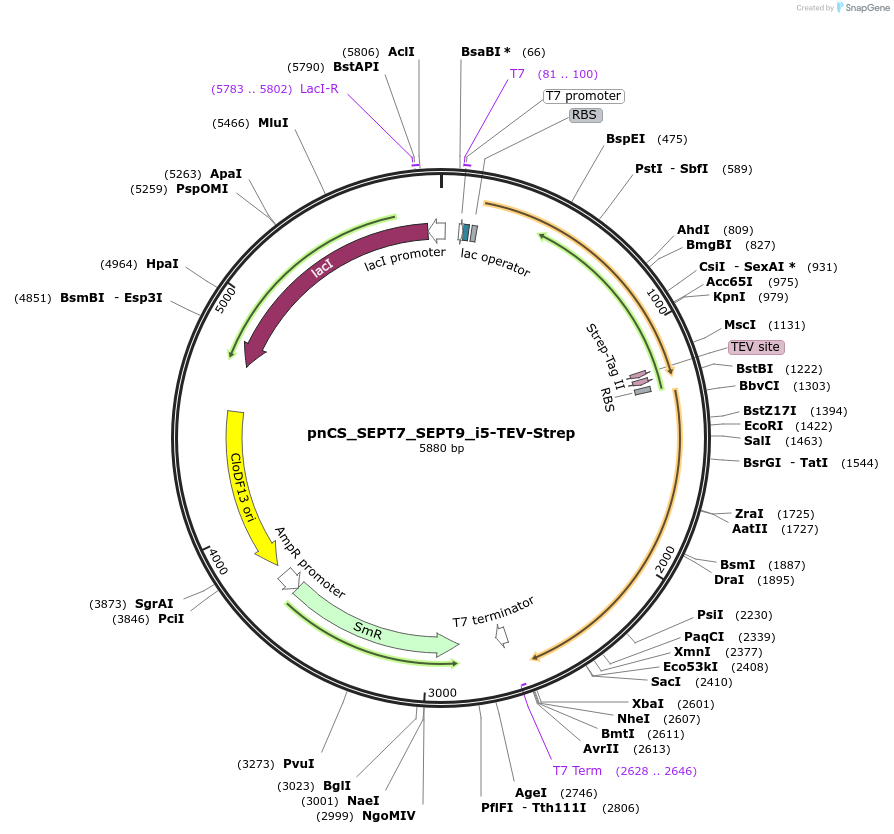pnCS_SEPT7_SEPT9_i5-TEV-Strep
(Plasmid
#174502)
-
Purposebacterial co-expression of human SEPT7 and of human SEPT9_i5
-
Depositing Lab
-
Sequence Information
Ordering
| Item | Catalog # | Description | Quantity | Price (USD) | |
|---|---|---|---|---|---|
| Plasmid | 174502 | Standard format: Plasmid sent in bacteria as agar stab | 1 | $85 | |
Backbone
-
Vector backbonepnCS
- Total vector size (bp) 5581
-
Vector typeBacterial Expression
Growth in Bacteria
-
Bacterial Resistance(s)Spectinomycin, 50 μg/mL
-
Growth Temperature37°C
-
Growth Strain(s)DH5alpha
-
Copy numberHigh Copy
Gene/Insert 1
-
Gene/Insert nameSEPTIN7
-
Alt nameSEPT7
-
SpeciesH. sapiens (human)
-
Entrez GeneSEPTIN7 (a.k.a. CDC10, CDC3, NBLA02942, SEPT7, SEPT7A)
Cloning Information for Gene/Insert 1
- Cloning method Gibson Cloning
- 5′ sequencing primer N/A
- 3′ sequencing primer N/A (Common Sequencing Primers)
Gene/Insert 2
-
Gene/Insert nameSEPTIN9
-
Alt nameSEPT9
-
Alt nameSEPT9 isoform 5
-
SpeciesH. sapiens (human)
-
Entrez GeneSEPTIN9 (a.k.a. AF17q25, MSF, MSF1, NAPB, PNUTL4, SEPT9, SINT1, SeptD1)
-
Tag
/ Fusion Protein
- TEV-Strep (C terminal on insert)
Cloning Information for Gene/Insert 2
- Cloning method Gibson Cloning
- 5′ sequencing primer N/A
- 3′ sequencing primer N/A (Common Sequencing Primers)
Resource Information
-
Supplemental Documents
Terms and Licenses
-
Academic/Nonprofit Terms
-
Industry Terms
- Not Available to Industry
Trademarks:
- Zeocin® is an InvivoGen trademark.
Depositor Comments
SEPT9 isoform 5 is the protein product of transcript variant 7 (NCBI Reference Sequence: NP_001106968.1).
These plasmids were created by your colleagues. Please acknowledge the Principal Investigator, cite the article in which the plasmids were described, and include Addgene in the Materials and Methods of your future publications.
-
For your Materials & Methods section:
pnCS_SEPT7_SEPT9_i5-TEV-Strep was a gift from Manos Mavrakis (Addgene plasmid # 174502 ; http://n2t.net/addgene:174502 ; RRID:Addgene_174502) -
For your References section:
Insights into animal septins using recombinant human septin octamers with distinct SEPT9 isoforms. Iv F, Martins CS, Castro-Linares G, Taveneau C, Barbier P, Verdier-Pinard P, Camoin L, Audebert S, Tsai FC, Ramond L, Llewellyn A, Belhabib M, Nakazawa K, Di Cicco A, Vincentelli R, Wenger J, Cabantous S, Koenderink GH, Bertin A, Mavrakis M. J Cell Sci. 2021 Jul 8. pii: 270842. doi: 10.1242/jcs.258484. 10.1242/jcs.258484 PubMed 34237139

